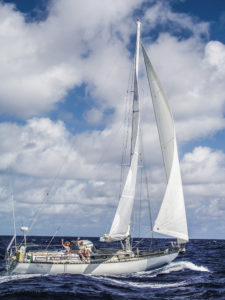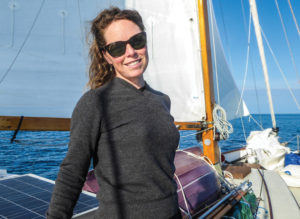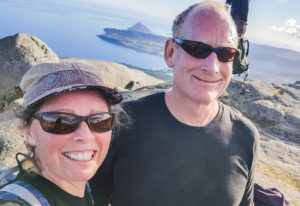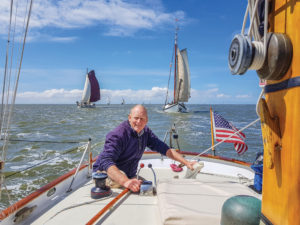This article originally appeared in the April 2022 issue of 48° North.
Land ho!” I looked up to see Ginger peering down the companionway hatch, grinning widely. “Mountains!” she pointed to port. We weren’t surprised that we were close enough to land to see the mountain tops on Vancouver Island that were now visible peeking above the clouds. Our chartplotter kept us well aware of our progress and we knew exactly where we were. The surprise was that we could see anything at all beyond our lifelines. Our ketch Irene was approaching the entrance to the Strait of Juan de Fuca, a notoriously foggy place, and we had expected to sail into the strait blanketed by fog, which seems to happen here more often than not.

When I climbed up on deck a few minutes later, the fog that we had been sailing in ever since departing Dutch Harbor ten days prior was dissipating quickly, displaced by glorious sunshine. Ginger pointed out the Olympic mountains, a stunning sight to starboard, and the gray ocean had now turned deep blue in the sun, flecked by whitecaps.
Approaching a destination after any ocean passage is always a happy time for us, but this was an extra special landfall. We were returning home from our second circumnavigation, four years after departure. This was no ordinary round-the-world trip, however, for a number of reasons. We went eastabout, transited the Northwest Passage and the Suez Canal, and were boat-bound by covid quarantine restrictions for more than 300 days (a story we’ll share in an upcoming issue of 48° North).
But here we were, sailing home to the Pacific Northwest, overwhelmed with gratitude and happiness as Irene flew on, sheets eased and bathed in sunshine. And as a special bit of luck, we entered Neah Bay in the last of the afternoon breeze and dropped the anchor just after sunset. There was a little bit of light left in the day to avoid crab pot buoys and enjoy the familiar scenery. We joked that Irene must have been confused by a change in time zone — she seems to normally like to end passages, wherever we may be, in the wee hours well after dark. That night at anchor was calm and blissful, and we were in home waters, finally!
The sloop Marcy
Ginger and I have been living the life of a voyaging pair since 2004, when we bought a homebuilt 47-foot sloop, Marcy, with lines very similar to a Swan 47. We repaired and re-rigged her, moved aboard, enjoyed a couple of seasons cruising the Salish Sea, and then headed out the Strait of Juan de Fuca to the open ocean and turned south towards Mexico. It’s an understatement to say that we enjoyed life afloat, and over the next four years we sailed around the world westabout by way of the Cape of Good Hope and Cape Horn.

All voyages must end; and, when we returned to Shilshole Bay Marina in 2010, we suffered some culture shock. We had no clear idea of what to do next. We each found employment and I assumed we would move ashore. “Oh no,” Ginger said. “No, we need to stay afloat, I love this life. Our friends are on the water. In fact, did I see you ogling a boat for sale on the next dock over? Maybe we need a new boat, one with standing headroom for you.” It’s a truism that among cruising couples, gung-ho guys are a dime a dozen, but women that wholeheartedly enjoy life at sea are less common and more wonderful. Who is this salty sailor woman?
Chief Mate Ginger grew up sailing on the family’s Lake-Union-built 24-foot wooden sloop Nanke, sailing from Shilshole. She has memories of sailing around Bainbridge Island, and up to the San Juan Islands. Not a fearful girl, she remembers enjoying the feel of heeling and the sight of the lee rail dipping under the waves most of all. After those early sailing experiences, her time on the water was limited to canoeing and rowing while family, hiking, and climbing filled our time until we bought Marcy. Those experiences obviously prepared her well for time on the ocean and strengthened her self-sufficiency.
We did buy that boat I was ogling on the next dock, the ketch Irene, and after selling Marcy we began planning another long voyage. How lucky am I?
The Ketch Irene

At 50 feet, Irene is a scaled down Herreshoff’s 72-foot classic, Ticonderoga. Irene is as different as can be from Marcy — we moved from a fin keel sloop with spade rudder to a long-keeled, heavy displacement ketch. We added the equipment needed for offshore sailing, including autopilot and wind vane for steering, and a dog house to shelter the watchkeeper. We rigged her with Dyneema standing rigging and bought a new suit of sails. A long summer trip up the Inside Passage to Sitka, then across the Gulf of Alaska to Kodiak and the Aleutians convinced us that we were on the right track.
We returned south to Port Townsend to winter over, where we fitted a Max Prop and the Shipwrights Co-op beefed up the autopilot ram for us. We set out again the next spring, in 2018, when Irene took us directly to Dutch Harbor, then Nome, then through the Northwest Passage to Greenland, and Maine. Our successful transit of the Northwest Passage made us the 30th U.S.-flagged vessel ever to do so. We wintered that year in South Carolina.
It is said that each new boat teaches new lessons, and Irene’s capabilities changed our approach to our time at sea. At first, we struggled with learning correct sail combinations for wind strength and sea state; but once that was dialed in, we found that we could really relax in rough conditions. We no longer worried about gales, as Irene’s heavier displacement and good design results in an easy motion. In fact, we began to enjoy gales — we sailed through the ones that blew in our direction, and hung on. And if the sea state was too rough or the wind blowing the wrong way, even better — we hove-to. Irene rides the seas like a duck, and we retire to the cabin for the duration of a blow. Cook, eat, lie in the bunk, read — it’s a vacation from the passage, in a way.
The lessons that Marcy taught also stayed with us. She sailed so well in light winds that we sailed as much as possible, even in the softest breezes. At one point, Marcy’s motor was out of commission during a passage as we blundered into an area of high pressure. The sea was glassy and there was no discernable wind, but we had a spinnaker set. As the swell rolled us one way, the sail collapsed against the rig, but as we rolled back the other way the sail filled with a bang. In this manner the boat kept steerageway and we kept moving. It was a bit noisy, but we were amazed to manage almost 50 miles a day for the two days and nights until the wind filled in. Like our first boat, Irene also turned out to be capable of ghosting along in very light airs despite her weight and wetted surface.

We also enjoy sailing to and off our anchor or even to or away from a dock, wall, or pontoon when it is allowed. This is good entertainment and helps keep our maneuvering-under-sail skills as sharp as possible. To some people, it may seem like a strange sport, ignoring a perfectly good motor. It comes no doubt from years of sailing small engineless boats in my youth. One of the wonderful things about voyaging under sail is that there is no governing body or rule book. Each skipper can develop and practice the aspects of the sport that he or she wishes. We’ve been known to pick up our crab pots under sail, just for the heck of it.
Over the next years, Irene took us around the world again, this time eastabout by way of the Suez Canal. We had significant challenges when covid changed the world and threw us some big surprises. For one thing, we spent way too much time in quarantine — not allowed ashore for months. But we arrived home with our boat, marriage and sense of humor intact; and we consider the voyage a success. Consequently, I consider myself to be a very lucky skipper.
Skipper Peter is just a boat geek. For me it’s always been all about the boats — paddling, rowing, sailing, and cruising, plus building them from an early age. I started in Sabots and El Toros, moving to bigger dinghies both racing and cruising. In the Salish Sea, there was a wonderful revival of interest in wooden and classic boats of all types starting in the 1970s, and it’s still going strong to this day. My cruising life began exploring the waters of the Salish Sea at this time (‘70s) in open boats without motors. When you think about it, what better school exists to teach what there is to know about weather,
tide, current, and adventure?
Back in Home Waters

In 2021, our return to the Salish Sea was different from our homecoming in 2010. This time, we returned feeling calm and surer of ourselves. We had a plan. Last time we sailed
directly to our home marina at Shilshole and jumped immediately back into “life.” That may have been a mistake. On this return, we gave ourselves a couple of months to cruise, easing back into local waters and visiting friends, before heading to the home marina.
We visited with friends both new and familiar in every anchorage through the end of summer and into fall. It was good to be back home among “our people.” The conversation flowed easily and the days passed in a lazy end-of-summer-way as we hopped between the San Juan Islands, Port Townsend, and Bainbridge Island. And speaking of anchorages, what a pleasure to watch Salish mariners go about anchoring. With so much practice and typically excellent ground tackle, our competent compatriots set their gear quietly and efficiently and are set for the night. Our waters are some of the best in the world for training sailors about anchoring and it shows in the generally high skill level exhibited in the Salish Sea.
We plan now to keep our sailing close to home, at least until covid is not as much an issue as it still is for international travel. And before any sailing at all, Irene needs a good refit. All those miles took their toll on her; and cleaning, repairing and painting will replace reefing, anchoring, and navigating over the next months. We will be supported by our excellent PNW industry providers — so many boatyards and craftspeople expert in all maritime trades and suppliers of all types are available here. The world does not offer many concentrations of nautical expertise like the Salish Sea does. Irene has been hauled out in Port Townsend where support for a refit is strong and well augmented by local breweries and coffeehouses. Yet another reason to be grateful….






